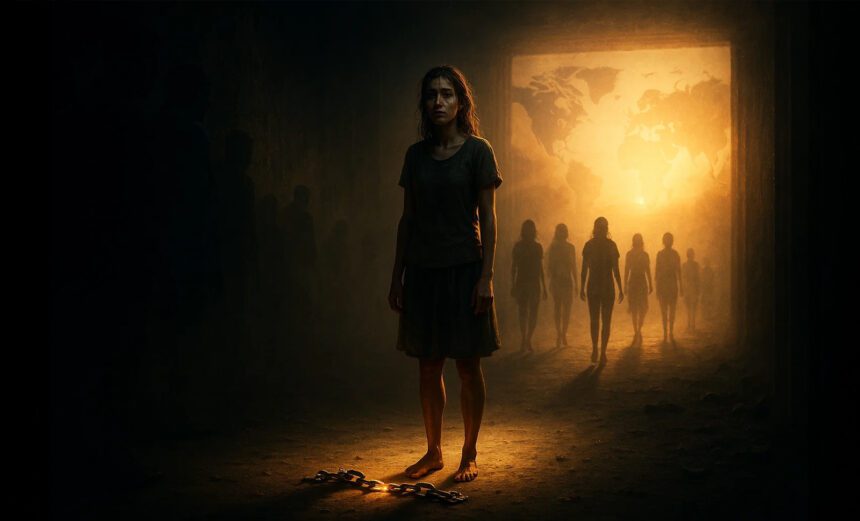Human trafficking, often called modern-day slavery, remains one of the world’s most urgent human rights crises. Despite global awareness and international laws, an estimated 50 million people are trapped in forced labor, sexual exploitation, and other forms of exploitation, according to the International Labour Organization (ILO). This hidden crime transcends borders, affecting both developing and developed nations alike. Traffickers prey on poverty, conflict, and desperation, turning human lives into commodities to be bought, sold, and exploited.
Trafficking occurs in almost every country, whether as a source, transit, or destination. The United Nations Office on Drugs and Crime (UNODC) reports that Asia and the Pacific account for the largest number of victims, followed by Africa and Europe. However, the problem is global. The United States, India, China, Nigeria, and Russia are among the major countries where trafficking networks operate most extensively. In these regions, criminal organizations exploit weak law enforcement, border vulnerabilities, and online anonymity to recruit and move victims across borders.
The victims of trafficking come from all walks of life but share one thing in common: vulnerability. Globally, women and girls make up nearly 71% of all trafficking victims, while one in three is a child. Many are lured with false promises of employment, education, or marriage. Once trapped, they are forced into labor in factories, domestic servitude, prostitution, mining, or agriculture. Children as young as five have been found working under brutal conditions, often sold by desperate families or abducted by traffickers. The average price of a trafficked person today is shockingly low, between $90 and $1000, making human beings cheaper than some electronic gadgets.
The reasons behind trafficking are deeply rooted in social and economic inequalities. Poverty and lack of employment push millions into dangerous migration routes in search of better opportunities. Gender inequality makes women and girls easy targets for sexual exploitation. Armed conflicts and political instability displace entire communities, leaving refugees and migrants at the mercy of traffickers. Corruption and weak law enforcement allow criminal networks to thrive with little fear of punishment. In recent years, the rise of social media and the dark web has made trafficking harder to detect, with traffickers using fake job advertisements and online grooming tactics to lure victims.
To combat this, governments and international organizations have intensified their efforts to fight trafficking through stronger laws, cross-border cooperation, and victim rehabilitation programs. The United Nations’ Sustainable Development Goal 8.7 calls for the eradication of forced labor, modern slavery, and child labor by 2030. Countries like Norway, the Netherlands, and Australia have introduced transparency laws that require companies to disclose their supply chain practices to prevent forced labor. In the United States, the Trafficking Victims Protection Act funds victim support programs and sanctions countries that fail to take action against traffickers. India’s Anti-Trafficking Bill aims to unify prevention, protection, and rehabilitation efforts under one framework.
Non-governmental organizations such as Polaris, International Justice Mission (IJM), and Anti-Slavery International play a crucial role in this global fight. They conduct rescue missions, provide legal aid, and help survivors rebuild their lives. Survivor-led networks are also emerging, giving victims a platform to advocate for change and share their stories of courage.
Technology, once a tool of exploitation, is now being used to fight back. Artificial intelligence and data analytics are helping law enforcement detect suspicious online activities and recruitment patterns. Blockchain technology is being explored to make labor supply chains more transparent and traceable. In several countries, hotlines and mobile apps enable victims to seek help anonymously and safely. These technological advances, combined with increased awareness, are slowly shifting the balance in the battle against trafficking.
However, the road to ending modern slavery is long and complex. Laws alone are not enough. There must be a coordinated global effort involving governments, businesses, civil society, and ordinary citizens. Consumers can help by choosing fair-trade products, supporting ethical brands, and reporting suspicious activities. Governments must strengthen enforcement, close legal loopholes, and ensure that survivors receive not just rescue but rehabilitation and dignity.
Human trafficking is not only a crime, it is an assault on humanity. Every rescue represents a small victory in a global struggle for freedom. As one survivor from Southeast Asia said, “Freedom is not given; it’s fought for one rescue at a time.” Ending modern slavery will require persistence, compassion, and global solidarity. Only then can the promise of freedom become a reality for all.


















